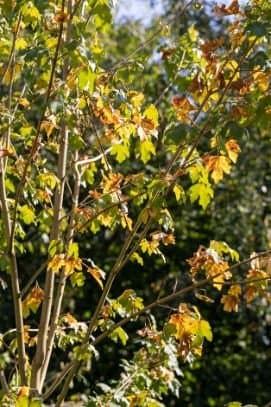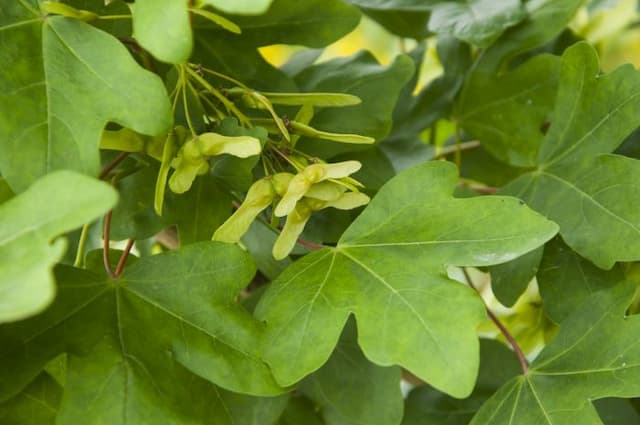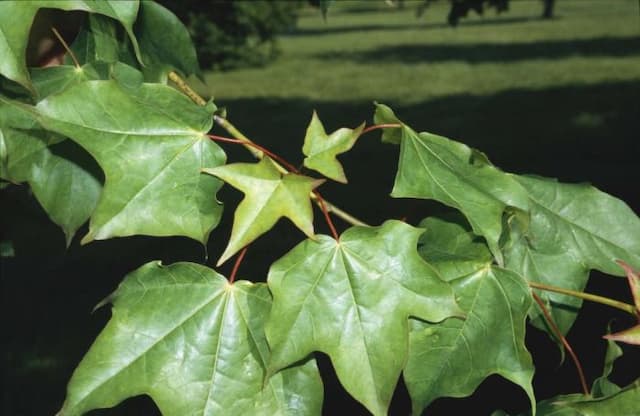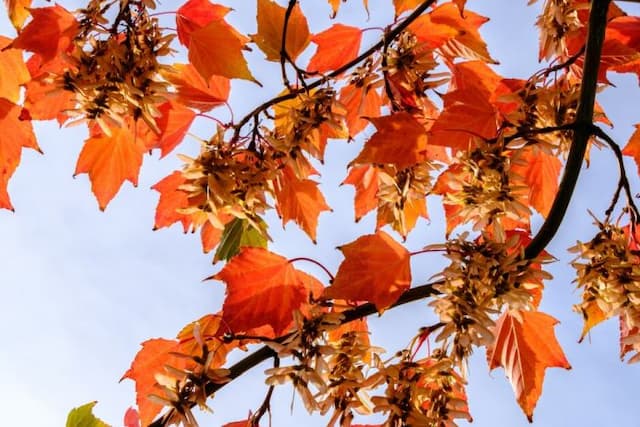Red Horse Chestnut Aesculus × neglecta 'Erythroblastos'

ABOUT
Commonly known as the autumn splendor horse chestnut, this ornamental plant is recognized for its distinctive foliage that undergoes a captivating color transformation throughout the seasons. During the spring, the new leaves emerge with a pronounced pink to salmon flush, setting it apart from other garden plants. As the leaves mature, they transition into a striking lime green or yellowish hue, creating a vibrant contrast against the backdrop of the customary green landscape. The leaves are composed of five to seven leaflets that radiate from a central point, resembling an open hand, which is typical of the horse chestnut family. This palmate arrangement contributes to a lush, full appearance that adds texture and visual interest to any garden setting. In the course of the year, the plant produces upright clusters of flowers. These blossoms can be quite showy, adding an additional layer of ornamental value. The flowers' hues typically range from creamy white to pale pink, which further complement the changing foliage. After the flowering season, non-edible, capsule-like fruit encasing large, shiny seeds may develop. These seeds are often referred to as "conkers" and can be an identifying feature of the plant. Overall, the autumn splendor horse chestnut presents a harmonious blend of colors, from its unique foliage to its graceful flowers, providing a dynamic and changing display that captivates the attention of gardeners and onlookers alike. Its capacity to shift hues with the seasons makes it a favored choice among plants for landscaping that can offer year-round visual interest, barring the details of its size or growth habit.
About this plant
 Names
NamesFamily
Sapindaceae.
Synonyms
Red Horse Chestnut, Erythroblastos Horse Chestnut.
Common names
Aesculus × neglecta 'Erythroblastos'.
 Toxicity
ToxicityTo humans
The Erythroblastos Red Horsechestnut is known to contain toxic compounds, particularly saponins and glycosides such as aesculin. If ingested, these compounds can cause symptoms of poisoning, which may include nausea, vomiting, diarrhea, abdominal pain, and in severe cases, muscle weakness, paralysis, dilated pupils, and depression of the central nervous system. It is important for humans to avoid consuming any parts of the plant, as serious health consequences can occur.
To pets
The Erythroblastos Red Horsechestnut is toxic to pets due to the presence of saponins and glycosides. If a pet ingests parts of this plant, symptoms of poisoning may manifest, including vomiting, diarrhea, depression, weakness, and potentially dilated pupils in severe cases. It is crucial to prevent pets from consuming any portion of the plant to avoid these adverse health effects.
 Characteristics
CharacteristicsLife cycle
Perennials
Foliage type
Deciduous
Color of leaves
Varies
Height
15 feet [4.57 meters]
Spread
15 feet [4.57 meters]
Plant type
Tree
Hardiness zones
5
Native area
Cultivar
Benefits
 General Benefits
General Benefits- Ornamental Value: Aesculus × neglecta 'Erythroblastos', commonly known as Red Horse Chestnut, has attractive foliage and flowers that enhance the visual appeal of gardens and landscapes.
- Shade Providing: Mature trees can offer a substantial amount of shade, creating cool areas in gardens and reducing the need for air conditioning in nearby buildings.
- Wildlife Attraction: The flowers of Red Horse Chestnut can attract pollinators like bees, while the seeds are a food source for certain wildlife species.
- Seasonal Interest: This tree provides seasonal interest with changes in leaf color, especially with the young pink leaves turning green, and then yellow in the fall.
- Urban Tolerance: Red Horse Chestnut is relatively tolerant to urban pollution, making it a suitable choice for city environments.
- Low Maintenance: Once established, the tree typically requires minimal care, aside from occasional watering and pruning to maintain its shape and health.
 Medical Properties
Medical PropertiesThis plant is not used for medical purposes.
 Air-purifying Qualities
Air-purifying QualitiesThis plant is not specifically known for air purifying qualities.
 Other Uses
Other Uses- Pigment source: The young pink leaves of the Horse Chestnut can be used to create natural dyes for textiles and artwork.
- Fish poison: In some cultures, compounds found in the tree leaves have been used historically to stun fish, making them easier to catch.
- Photography: The tannin-rich bark has potential applications for alternative photographic processes, like anthotype photography.
- Education: Its unique foliage color provides an excellent study specimen for botany students learning about chlorophyll deficiency.
- Biodegradable utensils: The wood, while not very strong, can be crafted into simple tools and utensils that are biodegradable.
- Seasonal decoration: Branches with distinctive pink leaves can be incorporated into floral arrangements or used as subtle decorations during the spring.
- Craft material: Dried branches and seed casings can be used in crafting activities, such as making wreaths or natural jewelry.
- Ballast for model making: The seeds can act as ballast or to add texture in model landscapes for dioramas or model railways.
- Sound insulation: The fibrous wood can be used as a natural sound insulating layer in eco-friendly construction projects.
- Horticultural training: The grafting techniques required to cultivate 'Erythroblastos' provide an advanced training opportunity for horticulturists.
Interesting Facts
 Feng Shui
Feng ShuiThe Red Horse Chestnut is not used in Feng Shui practice.
 Zodiac Sign Compitability
Zodiac Sign CompitabilityThe Red Horse Chestnut is not used in astrology practice.
 Plant Symbolism
Plant Symbolism- Resilience: Aesculus × neglecta 'Erythroblastos', commonly referred to as the Red Horse Chestnut, may symbolize resilience as horse chestnuts are known for their ability to withstand harsh conditions and recover from damage.
- Beauty in Contrast: This particular cultivar, with its unique reddish-pink foliage that contrasts with the green prevalent in most landscapes, exemplifies beauty in contrast, representing the idea of standing out and being unique in one's environment.
- Prosperity and Abundance: Horse chestnuts have historically been associated with prosperity due to their bountiful seeds, which in some cultures are considered to hold luck or the potential for growth and abundance.
- Strength and Stability: The sturdy trunks and extensive root systems of horse chestnuts contribute to their symbolic representation of strength and stability, reflecting a grounded nature and reliable presence.
- Renewal: With their deciduous nature, shedding leaves in the fall and regrowing them in the spring, Red Horse Chestnuts embody the cycle of renewal and the rebirth that comes with each season.
 Water
WaterThe Red Buckeye, commonly known as Aesculus × neglecta 'Erythroblastos', should be watered deeply once a week, providing about 1 to 1.5 gallons of water each time, depending on the weather conditions and soil drainage. During hot, dry spells, watering frequency may need to increase to twice a week. Allow the top inch of soil to dry out before watering again to prevent overwatering. It is important not to let the soil become waterlogged, as this can lead to root rot. Always water the base of the plant, avoiding wetting the foliage, to minimize the risk of fungal diseases.
 Light
LightThe Red Buckeye prefers to be placed in a spot with full sun to partial shade for optimal growth. Too much shade may lead to fewer flowers and a leggy growth habit, while too much direct sun can scorch the leaves, especially in hotter climates. An ideal location offers morning sunlight with some afternoon shade, especially in areas with intense midday sun.
 Temperature
TemperatureThe Red Buckeye can tolerate a range of temperatures but thrives best when the temperature is between 60°F and 80°F. It is hardy and can survive minimum winter temperatures down to about -20°F. During hot summer weather, the plant benefits from extra watering if temperatures consistently rise above 90°F.
 Pruning
PruningThe Red Buckeye requires little pruning other than to remove any damaged or diseased wood and to maintain its shape. Pruning is best done in the late winter or early spring before new growth begins. Occasional thinning of the branches may be necessary to allow light and air to penetrate the canopy, encouraging a healthy growth habit.
 Cleaning
CleaningAs needed
 Soil
SoilThe Red Horse Chestnut requires well-draining, fertile soil with a pH of 6.0 to 7.5. A good mix would include loamy soil, compost, and a small amount of sand to improve drainage. Regular mulching can also help to maintain soil moisture and health.
 Repotting
RepottingRed Horse Chestnut trees do not typically undergo repotting as they are large trees best suited for outdoor planting. Instead, they may require occasional transplanting when they outgrow their location, generally every few years during their juvenile stage or as needed.
 Humidity & Misting
Humidity & MistingThe Red Horse Chestnut thrives in average outdoor humidity levels. While specific humidity requirements are not critical for this tree, it benefits from the natural variations of outdoor conditions without needing special attention to humidity.
 Suitable locations
Suitable locationsIndoor
Not suitable for indoor growth due to size.
Outdoor
Plant in full sun to partial shade in fertile, moist soil.
Hardiness zone
4-8 USDA
 Life cycle
Life cycleThe Red Horse Chestnut 'Erythroblastos', Aesculus × neglecta 'Erythroblastos', begins its life cycle as a seed, typically a shiny, dark brown nut encased in a prickly husk which falls to the ground in autumn. Upon germination, which may require a period of cold stratification, the seedling emerges with the first pair of leaves and begins to establish a root system. As the sapling grows, it develops a distinctive pink-tinged foliage in spring, which matures to a pale yellow-green color throughout the growing season. The plant reaches maturity in several years, at which point it produces its characteristic panicles of red or pink flowers, usually around late spring to early summer. After pollination, often by bees, the flowers develop into the species’ fruit, the spiny husks containing the seeds. The cycle is completed as the seeds drop in the autumn and potentially germinate to produce new saplings, continuing the species' life cycle.
 Propogation
PropogationPropogation time
Early spring
Aesculus × neglecta 'Erythroblastos', commonly known as the Red Horse Chestnut, is typically propagated by grafting, which is the most popular method used for this plant. The best time to graft Red Horse Chestnuts is in late winter or early spring before new growth begins. To propagate by grafting, a scion, which is a short length of stem with several buds, is taken from a healthy, disease-free parent plant. This scion is then joined to a rootstock, which is often seed-grown Horse Chestnut or a closely related species, by making matching cuts on both the scion and the rootstock and binding them together until they fuse. The grafting site should be kept moist and wrapped to encourage successful union, with grafting tape or similar materials. After the graft has taken, usually evident by the growth of new shoots from the scion, the tape can be removed, and the new plant can continue growing with the combined characteristics of the scion and rootstock.









